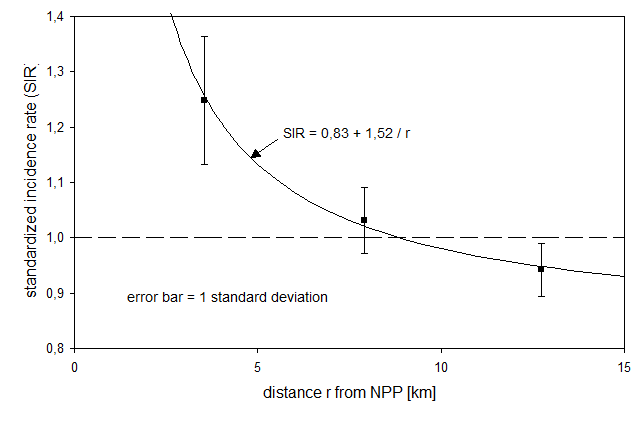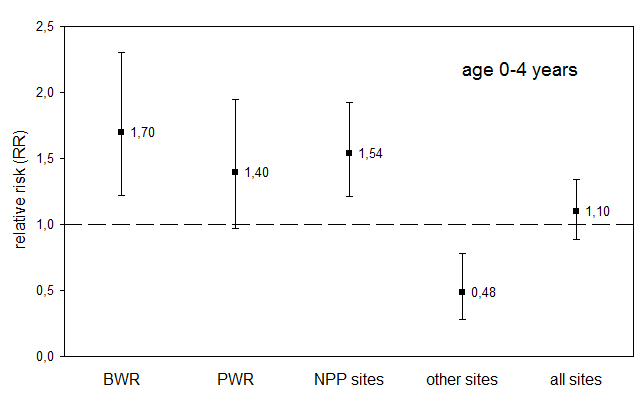Official German studies
An official German study was published in
1997 by the Institute of Medical Statistics and Documentation (IMSD), University
of Mainz (Germany). The study was based on data from the German Childhood Cancer
Registry, 1980-1995.
Main result: No increased risk of childhood cancer in the vicinity of 20 West
German nuclear facilities
(relative risk: RR=0.99 in 0-15 km zone and RR=1.04 in 0-5 km zone). The IMSD study also reported a
25% increase of cancer rates in the 15-km zone of nuclear facilities in the
former GDR. This increase is significant (p=0.045) when a one-sided test is
used.
Already in 1995, the Federal Office of Radiation Protection (Bundesamt für Strahlenschutz, BfS) had conducted a study of childhood cancer rates in the 15-km zone around 5 Bavarian nuclear facilities (3 NPP sites, 1 small research reactor (4 MWth), one small experimental reactor (16 MWel), decommissioned in 1985). No increased cancer risk was detected.
Thus, until 1997, all official German studies of childhood cancer incidence near nuclear facilities reported negative results.
IMSD study revisited (1998)
In addition to sites of commercial nuclear power plants, the authors of the IMSD study had included sites of two nuclear research facilities (Karlsruhe and Jülich), one small research reactor (Kahl, capacity 16 MWel) that was decommissioned in 1985, one prototype high temperature reactor (Hamm-Uentrop, 307 MWel) that operated for a total of about 400 days, and a commercial reactor (Mülheim-Kärlich) that operated for several months. When the data analysis was restricted to the 15 commercial nuclear power plants and to the 5-km zone, a significant 22% increase of childhood cancer rates (p=0.047) was found.
The IMSD study also provides data of standardized incidence rates (SIR) for 3 distance zones (0-5 km, 5-10 km, 10-15 km). The cancer rates decrease with increasing distance from the NPP site as can be seen from the figure below.

In the 5 km zone, the increase of cancer rates for children below age 5 is 54% (p=0.0034). An even higher 76% increase of leukemias is found (p=0.012).
The figure below shows the relative
risk, i.e., the cancer rates in the study area divided by the rates in a control
area far from the NPP site, for all 15 NPP sites, for boiling water (BWR) and
for pressurized water (PWR) reactors, for the 5 sites of experimental and
research rectors (other sites) and for all sites combined.

Also the data used
in the BfS study for Bavaria yield a significant 35% increase of childhood cancers
(p=0.0043) when Garching and Kahl are omitted from the analysis, i.e., when
only the 3 Bavarian commercial NPP sites are included in the analysis.
Thus, data from official studies show significant increases of childhood cancer rates when restricted to commercial NPPs.
Reacting to considerable public concern, the BfS decided to commission a new case control study to investigate the reasons for the observed increase of cancer rates near Bavarian and German NPPs (KiKK study). The study started in 2003 and was supposed to be finished by the end of 2006. The results were eventually presented in December 2007.
References:
Körblein A, Hoffmann W. Childhood Cancer in the Vicinity of German Nuclear Power Plants.
Medicine & Global Survival, August 1999, Vol.6: 18-23 download
(PDF 371 kB)